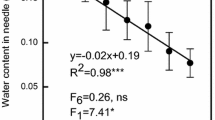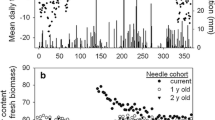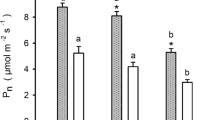Summary
Damage in the older needles of Norway spruce [Picea abies (L.) Karst.] in the Fichtelgebirge (NE Bavaria, FRG) appears to result primarily from nutrient imbalances rather than from direct effects of air pollutants on the mesophyll of the needles. Support for this conclusion was obtained by altering the nutrition of older needles through the removal of terminal buds on several branches from a damaged and an undamaged spruce tree in spring. Various photosynthetic parameters, as well as the chloroplast pigment and nutrient concentrations, of 1- to 3-year-old needles on manipulated branches were compared with those of branches on which the new flush was allowed to develop during the course of the growing period. Removal of terminal buds affected only the 1-year-old needles. Elimination of the new flush resulted in a higher Ca and Mn content of the needles of the undamaged tree. This treatment also resulted in an increase of the photosynthetic capacity (under saturating light and CO2 conditions), carboxylation and light use efficiency, as well as net photosynthesis under natural conditions of the 1-year-old needles on the yellow chlorotic tree. This was accompanied by higher chlorophyll concentrations and an increase in Mg, Ca, Mn, and Zn content, and no visible signs of chlorosis developed in the experiment. By contrast, the needles of twigs in which the new flush was allowed to develop exhibited reductions in mineral content in the middle of the year. This was especially true for the elements Mg and Ca, and was accompanied by needle chlorosis and a depression of the capacity of photosynthesis. Thus it appears that there is a close relationship between the development of needle damage and nutrient imbalances in spruce. The retranslocation of elements from the 1-year-old needles to the new flush seems to play a major role in the development of needle bleaching. This approach thus supports the hypothesis described above and confirms a preliminary test with a similar experimental design, which had been conducted earlier.
Similar content being viewed by others
References
Baule H, Fricker C (1967) Die Düngung von Waldbäumen. BLV, Munich
Beyschlag W, Lange OL, Tenhunen JD (1986) Photosynthese und Wasserhaushalt der immergrünen mediterranen Hartlaubpflanze Arbutus unedo L. im Jahreslauf am Freilandstandort in Portugal. I. Tagesläufe von CO2-Gaswechsel und Transpiration unter natürlichen Bedingungen. Flora 178: 409–444
Björkman O, Demmig B (1987) Photon yield of O2 evolution and chlorophyll fluorescence characteristics at 77 K among vascular plants of diverse origins. Planta 170: 489–504
Caemmerer S von, Farquhar GD (1981) Some relationships between the biochemistry of photosynthesis and the gas exchange of leaves. Planta 153: 376–387
Comstock J, Ehleringer J (1984) Photosynthetic responses to slowly decreasing leaf water potentials in Encelia frutescens. Oecologia 61: 241–248
Dorenstouter H, Pieters GA, Findenegg GR (1985) Distribution of magnesium between chlorophyll and other photosynthetic functions in magnesium deficient “sun” and “shade” leaves of poplar. J Plant Nutr 8: 1089–1101
Farquhar GD, Sharkey TD (1982) Stomatal conductance and photosynthesis. Annu Rev Plant Physiol 33: 317–345
Gezelius K, Ericsson A, Hällgren J-E, Brunes L (1981) Effects of bud removal in Scots pine (Pinus sylvestris) seedlings. Physiol Plant 51: 181–188
Hantschel R, Kaupenjohann M, Horn R, Zech W (1985) Wasser- und Elementtransport in unterschiedlich gedüng-ten, geschädigten Waldökosystemen. Z Dtsch Geol Ges 136: 473–480
Hoess P (1986) Nährstoffgehalte der Fichtennadeln (Picea abies) im Verlauf ihrer Altersentwicklung: Untersuchungen an einem geschädigten und einem ungeschädigten Baum im Fichtelgebirge. Diplomarbeit Univ Würzburg
Höhne H (1964) Untersuchungen über die jahreszeitlichen Veränderungen des Gewichtes und Elementgehaltes von Fichtennadeln in jüngeren Beständen des Osterzgebirges. Arch Forstwes 13: 747–774
Horn R, Zech W (1987) Zusammenhänge zwischen Boden-eigenschaften und Waldschäden. Allg Forst Z 12: 300–302
Hunger W (1974) Untersuchungen über die jahreszeitliche undjahrweise Fluktuation der Nährelementkonzentrationen in den Nadeln eines jüngeren Fichtenbestandes. Flora 163: 422–442
Koch W (1976) Blattfarbstoffe von Fichte [Picea abies (L.) Karst.] in Abhängigkeit vom Jahresgang, Blattalter und-typ. Photosynthetica 10: 280–290
Koch W, Lange OL, Schulze E-D (1971) Ecophysiological investigations on wild and cultivated plants in the Negev desert. I. Methods: a mobile laboratory for measuring carbon dioxide and water vapour exchange. Oecologia 8: 296–309
Köstner B (1989) Jahresverlauf der Chloroplastenpigmente von ungeschädigten und chlorotischen Fichten an einemWaldschadensstandort im Fichtelgebirge in Abhängigkeit vom Alter und Mineralstoffgehalt der Nadeln. Dissertation Univ Würzburg
Kriedemann PE, Loveys BR, Possingham JV, Satoh M (1976) Sink effects on stomatal physiology and photosynthesis. In: Wardlaw IF, Passioura JB (eds) Transport and transfer processes in plants. Academic Press, New York, pp 401–414
Kufner R (1977) Untersuchungen zum Stoffwechsel der Chloroplastenpigmente bei höheren Pflanzen. Dissertation Univ Würzburg
Laing WA, Christeller JT (1976) A model for the kinetics of activation and catalysis of ribulose 1,5-bisphosphate carboxylase. Biochem J 159: 563–570
Lange OL, Gebel J, Schulze E-D, Walz H (1985) Eine Methode zur raschen Charakterisierung der photosynthetischen Leistungsfähigkeit von Bäumen unter Freiland-bedingungen — Anwendung zur Analyse “neuartiger Waldschäden” bei der Fichte. Forstwiss Centralbl 104: 186–198
Lange OL, Führer G, Gebel J (1986) Rapid field determination of photosynthetic capacity of cut spruce twigs (Picea abies) at saturating ambient CO2. Trees 1: 70–77
Lange OL, Zellner H, Gebel J, Schramel P, Köstner B, Czygan F-C (1987) Photosynthetic capacity, chloroplast pigments, and mineral content of the previous year's spruce needles with and without the new flush: analysis of the forest-decline phenomenon of needle bleaching. Oecologia 73: 351–357
Lange OL, Weikert RM, Wedler M, Gebel J, Heber U (1989) Photosynthese und Nährstoffversorgung von Fichten aus einem Waldschadensgebiet auf basenarmem Untergrund. Allg Forst Z 3: 55–64
Larcher W (1980) Physiological plant ecology. Springer, Berlin Heidelberg New York
Lippert M (1988) Photosynthesekapazität, Chlorophyllgehalt und Nährstoffgehalte von Nadeln geschädigter und ungeschädigter Fichten mit und ohne Konkurrenz des diesjährigen Triebs: Experimenteller Ansatz zur Analyse der Waldschäden im Fichtelgebirge. Thesis, Univ Würzburg
Lorimer GH, Badger MR, Andrews TJ (1976) The activation of ribulose-1,5-bisphosphate carboxylase by carbon dioxide and magnesium ions. Equilibra, kinetics, a suggested mechanism, and physiological implications. Biochemistry 15: 529–536
Lyr H, Polster H, Fiedler H-J (1967) Gehölzphysiologie. Fischer, Jena
Marschner H (1983) General introduction to the mineral nutrition of plants. In: Läuchli A, Bieleski RL (eds) Inorganic plant nutrition. Encyclopedia of plant physiology, new series 15A. Springer, Berlin Heidelberg New York, pp 5–60
Mengel K, Kirkby EA (1987) Principles of plant nutrition, 4thedn. International Potash Institute, Worblaufen — Bern
Metzner H, Rau H, Senger H (1965) Untersuchungen zur Synchronisierbarkeit einzelner Pigmentmangel-Mutanten von Chlorella. Planta 65: 186–194
Meyer J, Schneider BU, Werk K, Oren R, Schulze E-D (1988) Performance of two Picea abies (L.) Karst. stands at different stages of decline. V. Root tip and ectomycorrhiza development and their relations to above ground and soil nutrients. Oecologia 77: 7–13
Mies E, Zöttl HW (1985) Zeitliche Äderung der Chlorophyllund Elementgehalte in den Nadeln eines gelb-chlorotischen Fichtenbestandes. Forstwiss Centralbl 104: 1–8
Oren R, Schulze E-D (1989) Nutritional disharmony and forest decline: A conceptual model. In: Schulze E-D, Lange OL, Oren R (eds) Forest decline and acid rain. Ecological studies 77. Springer, Berlin Heidelberg NewYork, pp 325–443
Oren R, Schulze E-D, Matyssek R, Zimmermann R (1986) Estimating photosynthetic rate and annual carbon gain in conifers from specific leaf weight and leaf biomass. Oecologia 70: 187–193
Oren R, Schulze E-D, Werk KS, Meyer J, Schneider BU, Heilmeier H (1988a) Performance of two Picea abies (L.) Karst. stands at different stages of decline. I. Carbon relations and stand growth. Oecologia 75: 25–37
Oren R, Werk KS, Schulze E-D, Meyer J, Schneider BU, Schramel P (1988b) Performance of two Picea abies (L.) Karst. stands at different stages of decline. VI. Nutrient concentration. Oecologia 77: 151–162
Oren R, Schulze E-D, Werk KS, Meyer J (1988c) Performance of two Picea abies (L.) Karst. stands at different stages of decline. VII. Nutrient relations and growth. Oecologia 77: 163–173
Reemtsma JB (1986) Der Magnesium-Gehalt von Nadeln niedersächsischer Fichtenbestände und seine Beurteilung. Allg Forst-Jagdztg 157: 196–200
Rühle W, Wild A (1985) Die Anpassung des Photosyntheseapparates höherer Pflanzen an die Lichtbedingungen. Naturwissenschaften 72: 10–16
Schramel P (1988) ICP and DCP spectrometry for trace element analysis in biomedical and environmental samples. Spectrochim Acta 43 B: 881–896
Schulze E-D, Oren R, Zimmermann R (1987) Die Wirkungen von Immissionen auf 30-jährige Fichten in mittleren Höhenlagen des Fichtelgebirges auf Phyllit. Allg Forst Z 27/28/29: 725–730
Schulze E-D, Lange OL, Oren R, (eds) (1989a) Forest decline and acid rain. A study with Norway Spruce (Picea abies) on acid soils. Ecological studies 77. Springer, Berlin Heidelberg New York
Schulze E-D, Oren R, Lange OL (1989b) Nutrient relations of trees in healthy and declining Norway spruce stands. In: Schulze E-D, Lange OL, Oren R (eds) Forest decline and acid rain. Ecological studies 77. Springer, Berlin Heidelberg New York, pp 392–417
Smith E (1937) The influence of light and carbon dioxide onphotosynthesis. Genet Physiol 20: 807–830
Smith E (1938) Limiting factors in photosynthesis: light and carbon dioxide. Genet Physiol 22: 21–35
Steffen I, Schramel P (1988) Bestimmung von Stickstoff in Fichtennadeln. Laborpraxis 12: 1354–1361
Wareing PF, Khalifa MM, Treharne KJ (1968) Rate-limiting processes in photosynthesis at saturating light intensities. Nature 220: 453–457
Weber A, Czygan F-C (1972) Chlorophylle und Carotinoide der Chaetophorineae (Chlorophyceae, Ulotrichales). 1. Siphonaxanthin in Microthamnion kuetzingianum Naegeli. Arch Mikrobiol 84: 243–253
Wyttenbach A, Tobler L (1988) The seasonal variation of 20 elements in 1st and 2nd year needles of Norway spruce, Picea abies (L.) Karst. Trees 2: 52–64
Zech W, Popp E (1983) Magnesiummangel, einer der Gründe für das Fichten- und Tannensterben in NO-Bayern. Forstwiss Centralbl 102: 50–55
Author information
Authors and Affiliations
Rights and permissions
About this article
Cite this article
Weikert, R.M., Wedler, M., Lippert, M. et al. Photosynthetic performance, chloroplast pigments, and mineral content of various needle age classes of spruce (Picea abies) with and without the new flush: an experimental approach for analysing forest decline phenomena. Trees 3, 161–172 (1989). https://doi.org/10.1007/BF00226652
Received:
Issue Date:
DOI: https://doi.org/10.1007/BF00226652




